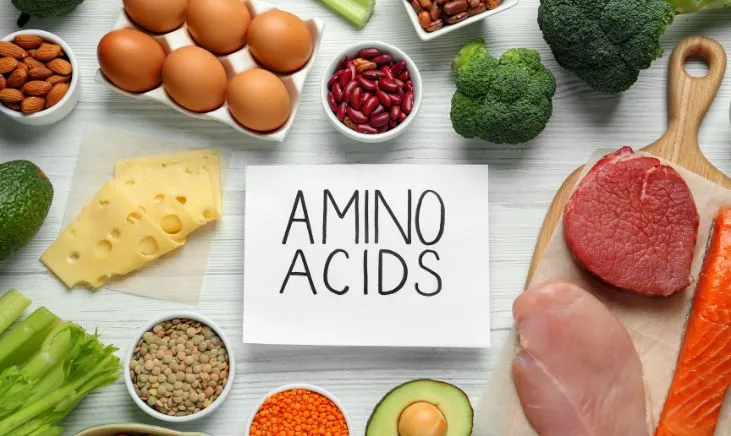There are twenty amino acids, each playing a vital part in the human body and its natural processes. Without the support of these different amino acids, typical functions of the body and its organs would be hindered, resulting in adverse health concerns.
Through a balanced diet, amino acids can be readily consumed and benefited from to improve and maintain quality health. There are also essential amino acid supplements and vegan amino acid supplements to consider, which can benefit individuals who struggle to eat a well-balanced diet, are under stress, or are suffering from injury.
This article details each amino acid and its roles, benefits, and the differences between each type of amino acid!
Table of Contents
List of Amino Acids: 20 Non-Essential Amino Acids & Essential Amino Acids
This list of 20 amino acids that are critical for the human body and all its functions goes into detail about every amino acid’s role. From decreasing muscle fatigue to managing blood sugar levels, continue reading to learn how each amino acid is important for the body’s natural processes!

Alanine
Alanine is a nonessential amino acid that acts as the building block for protein. It is one of the simplest amino acids with a methyl group as its side chain. Methyl groups are important for processes related to liver detoxification, gene expression, neurotransmitter synthesis, and epigenetics.
Roles of Alanine:
- Source of energy for the central nervous system and muscles
- Strengthens the immune system
- Decrease muscle fatigue
- Manages blood sugar levels
Arginine
A nonessential amino acid that is also one of the conditionally essential amino acids, arginine transforms into nitric oxide in the body. It is one of the building blocks of protein that is often used to improve circulation.
Roles of Arginine:
- Improves circulation
- Beneficial for sexual function
- Promotes muscle repair
- Decreases inflammation
- Stimulates the release of insulin and growth hormones
Asparagine
A nonessential amino acid, asparagine, is produced by the body. It is a necessary component in making neurotransmitters crucial for signaling to the brain.
Individuals with asparagine synthetase deficiency often have symptoms such as weak muscle tone (hypotonia) and exaggerated reflexes (hyperreflexia) which can ultimately lead to paralysis of the arms and legs (spastic quadriplegia).
Roles of Asparagine:
- Breaks down toxic ammonia within cells
- Produces neurotransmitters
- Aids in equilibrium maintenance
- Maintains metabolism activities in the brain
- Combats fatigue
- Protects the liver
Aspartic Acid
Another nonessential amino acid, aspartic acid, is crucial for making other amino acids. It synthesizes four essential amino acids, isoleucine, threonine, methionine, and lysine, which are significant in the health of vital organs and their systems.
Roles of Aspartic Acid:
- Helps make other amino acids
- Sends chemical signals through the nervous system
- Supports energy production
- Enhances athletic performance
- Regulates hormones
- Synthesizes proteins
Cysteine
Cysteine is one of the nonessential amino acids that is classified as a conditionally essential amino acid. This amino acid has powerful antioxidant nutritional benefits that are used to reduce the risk of cancer, diabetes, and stroke.
Roles of Cysteine:
- Reduces signs of aging in the skin
- Promotes healthy hair and reduces hair loss
- Protects the digestive system
- Important in wound healing processes
- Regulates activity in the immune system
- Reduces the risk of stroke
- Treats chronic inflammation
Glutamic Acid
Glutamic acid is a nonessential amino acid that acts as an excitatory neurotransmitter in the nervous system. This means the neurotransmitters actively engage the neurons to send messages passed on to other cells. Glutamic acid is crucial for the body’s processes as it aids nerve cells in sending and receiving information to promote action, learning, and memory.
Roles of Glutamic Acid:
- Plays a role in brain, metabolism, and cardiac processes
- Used in protein biosynthesis in the human body
- Keeps the skin’s pH value intact
- The main excitatory neurotransmitter of the central nervous system
Glutamine
Another conditionally essential amino acid that is typically a nonessential amino acid, glutamine is necessary for maintaining muscle protein. It is also vital for supporting immune function during stress or sickness.
Roles of Glutamine:
- Removes excess ammonia from the body
- Aids the immune system and its processes
- Maintains muscles protein
- Stimulates protein synthesis
Glycine
Glycine is a nonessential amino acid that acts as a conditionally essential amino acid in times of stress or injury. This amino acid is a neurotransmitter critical to the body’s processes for synthesizing the antioxidant glutathione. Glutathione is a powerful antioxidant that fights free radicals that can cause oxidative stress, damage DNA, and cause cancer.
Roles of Glycine:
- Contributes to cellular growth
- Synthesizes glutathione
- A neurotransmitter for the central nervous system
- Building blocks for proteins that are needed for hormone and tissue maintenance
- Used to make creatine
- The primary amino acid in collagen
Histidine
An essential amino acid, histidine is not naturally made in the body. It must be consumed through dietary means to support vital organ functions. Histidine is necessary for synthesizing proteins, and a deficiency in histidine can result in anemia and other concerns such as gastric hypochlorhydria.
Roles of Histidine:
- Repairs damaged tissue
- Creates blood cells
- Speeds up recovery of wounds
- Improves cognitive function
- Responsible for the synthesis of proteins
- Enhances insulin resistance
Isoleucine
Isoleucine is an essential amino acid and one of the three branched-chain amino acids. This amino acid is vital for muscle growth and recovery. It is also critical in physiological functions, like aiding in protein and fatty acid metabolism, and it has been discovered that isoleucine can restore the damage of pathogens on health.
Roles of Isoleucine:
- Helps make hemoglobin
- Controls blood sugar levels
- Boosts energy
- Improves endurance and athletic performance
- Supports muscle development
- Maintains immune function
Leucine
Leucine is an essential amino acid and branched-chain amino acid. This amino acid is crucial as it is necessary for protein synthesis. Due to its energy production and recovery benefits, it is one of the most utilized amino acids for muscle gain, training, and athletic performance.
Roles of Leucine:
- Regulates protein synthesis, metabolism, and tissue regeneration
- Can be used to generate ATP
- Improves athletic performance
- Boosts fat loss
- Stabilizes blood sugar levels
- Aids in muscle recovery
Lysine
An essential amino acid, lysine, is used to create carnitine, a substance that aids in converting body fat into energy. It is required to form collagen and improves wound healing by speeding up the healing process.
Roles of Lysine:
- Aids in the formation of collagen
- Used to create carnitine
- Lowers levels of cortisol
- Supports wound healing
- Required for the formation of collagen
Methionine
Methionine is an essential amino acid that is unique in that it contains sulfur. It is crucial for the body because it produces sulfur-containing molecules essential for DNA and cell function. Only methionine and cysteine, which also contains sulfur, can produce these molecules.
Roles of Methionine:
- Produces molecules for cell and DNA function
- Makes new proteins inside cells
- Helps break down fats
- Aids the digestive system
- Supports liver health
Phenylalanine
One of the nine essential amino acids, phenylalanine, is important for many reasons. One example is that phenylalanine is necessary for producing other molecules such as dopamine, tyrosine, epinephrine, and norepinephrine. When there is dysfunction concerning these molecules, it can cause adverse health effects such as depression.
Roles of Phenylalanine:
- Used in the processes of making other molecules
- Promotes healthy mood
- Alleviates chronic pain
- Used to reduce symptoms of Parkinson’s disease, osteoarthritis, attention-deficit hyperactivity disorder (ADHD), and multiple sclerosis
Proline
Proline is another nonessential amino acid that acts as a conditionally essential amino acid. It plays an active role in protein synthesis, wound healing, and immune responses. Due to these significant qualities, proline becomes essential during times of stress, illness, or injury.
Roles of Proline:
- Promotes wound healing
- Strengthens immune responses
- Plays a role in protein synthesis and structure
- Needed to make collagen
- Benefits digestive health
Serine
Serine is a conditionally essential amino acid important in numerous bodily processes, including protein synthesis. It is especially significant in cognitive processes, such as improving cerebral blood flow and reducing symptoms of neuropathological conditions.
Individuals who suffer from serine deficiency may show signs of intellectual disability, seizures, developmental delay, or spastic quadriplegia.
Roles of Serine:
- Important in multiple body processes
- Lowers inflammation
- Reduces symptoms of neuropathological conditions
- Improves sleep
- Relieves stress
Threonine
Threonine is one of the nine essential amino acids. It supports many functions in the body, including the immune and digestive systems. This amino acid is also responsible for maintaining skin, muscle tissue, and teeth health.
Roles of Threonine:
- Maintains healthy skin, teeth, and muscle tissue
- Aids in digestion and metabolism
- Prevents fat buildup in the liver
- Boosts the immune system
- Enhances muscle strength
Tryptophan
The body uses an essential amino acid, tryptophan, to make two important hormones: melatonin and serotonin. Melatonin regulates the timing of the body’s circadian rhythm, which can directly affect sleep quality. Serotonin is a hormone and neurotransmitter that sends signals to the nerve cells and regulates multiple bodily functions, including mood and sleep.
Roles of Tryptophan:
- Used to make serotonin and melatonin
- Improves sleep and mood
- Reduces symptoms of PMS
- Enhances athletic performance
Tyrosine
A conditionally essential amino acid, tyrosine, acts as a chemical messenger to the brain. It serves as one of the building blocks of protein. Tyrosine also produces melanin, thyroid hormones, and enzymes, which are important in bodily processes like regulating metabolism.
Roles of Tyrosine:
- Helps produce enzymes, melanin, and thyroid hormones
- Improves mood
- Reduces stress
Valine
Valine is an essential amino acid and another of the branched-chain amino acids. This vital amino acid is productive in enhancing athletic performance by producing energy and aiding recovery.
Roles of Valine:
- Supplies the muscles with glucose for energy production
- Enhances athletic performance
- Improves gut health
- Aids in muscle tissue recovery and repair
- Lowers elevated blood sugar levels
- Boosts growth hormone production
The Amino Acid Types
There are different amino acid categories. It’s not just essential vs non essential amino acids. There are 20 amino acids in total and break down into different categories like essential, non essential, branched chain, and conditionally essential.
Each plays a significant role in the body’s processes and, if deficient by any means, can result in some sort of adverse health concern, like insomnia and muscle weakness. Find out more about the different amino acid types and their importance below!

The Nine Essential Amino Acids
The nine essential amino acids are important molecules the human body cannot make. These indispensable nutrients must be ingested through dietary means to support the functions of vital organs.
Any food containing these nine amino acids is called a complete protein.
The nine essential amino acids include:
- Histidine
- Isoleucine
- Leucine
- Lysine
- Methionine
- Phenylalanine
- Threonine
- Tryptophan
- Valine
Non Essential Amino Acids
Nonessential amino acids are naturally produced in the human body and do not need to be consumed through dietary means like the essential amino acids. These specific amino acids are important for energy production and immune function. They can also be converted into glucose by the body for energy.
The nonessential amino acids include:
- Alanine
- Arginine
- Asparagine
- Aspartic acid
- Cysteine
- Glutamic acid
- Glutamine
- Glycine
- Proline
- Serine
- Tyrosine
Branched Chain Amino Acids
Three amino acids comprise the branched-chain amino acids, named after their chemical structure. These amino acids are significant in regulating protein synthesis, turnover, gut health, and metabolism.
The branched-chain amino acids include:
- Valine
- Isoleucine
- Leucine
Conditionally Essential Amino Acids
Certain amino acids, considered conditionally essential amino acids, become necessary in times of stress or illness. These amino acids become limited under certain pathophysiological conditions, including pregnancy and infancy. Without supplementing these conditionally essential amino acids in a person’s diet during these times, the immune system and other important processes, such as wound healing, are significantly weakened.
The conditionally essential amino acids include:
- Arginine
- Cysteine
- Glutamine
- Tyrosine
- Glycine
- Proline
- Serine
Protein Synthesis and The Amino Acid Code
Protein synthesis is a biological process. During this process, amino acids form building blocks through peptide bonding in specific polypeptide sequences. These sequences are unique to the genetic blueprint encoded by deoxyribonucleic acid (DNA).
Genetic codes stored in DNA are responsible for encoding proteins in protein synthesis. The amino acid properties bind these molecules to form protein in a manner specified by RNA and transcribed by DNA.
Frequently Asked Questions
Are Amino Acids a Protein?
Amino acids are molecules that act as the building blocks of protein. When amino acids combine, they form proteins vital for bodily processes and life. Without amino acids, the body is negatively impacted, resulting in poor immune function, stunted growth in children, digestive issues, and other harmful side effects.
Which Foods Contain Amino Acids?
Plant proteins and animal proteins are all made up of various amino acids. Some are complete proteins, meaning they contain all nine essential amino acids. The proportion of these amino acids varies, with some having high, low, or none of specific amino acids, hence why it is so important to have a well-balanced diet.
What is the Structure of an Amino Acid?
Amino acids are composed of a side chain, alpha carbon, an amino group, and a carboxylic acid group. Most amino acids also have a chiral carbon so that the amino acid can rotate polarized light, which is important in protein biosynthesis.














